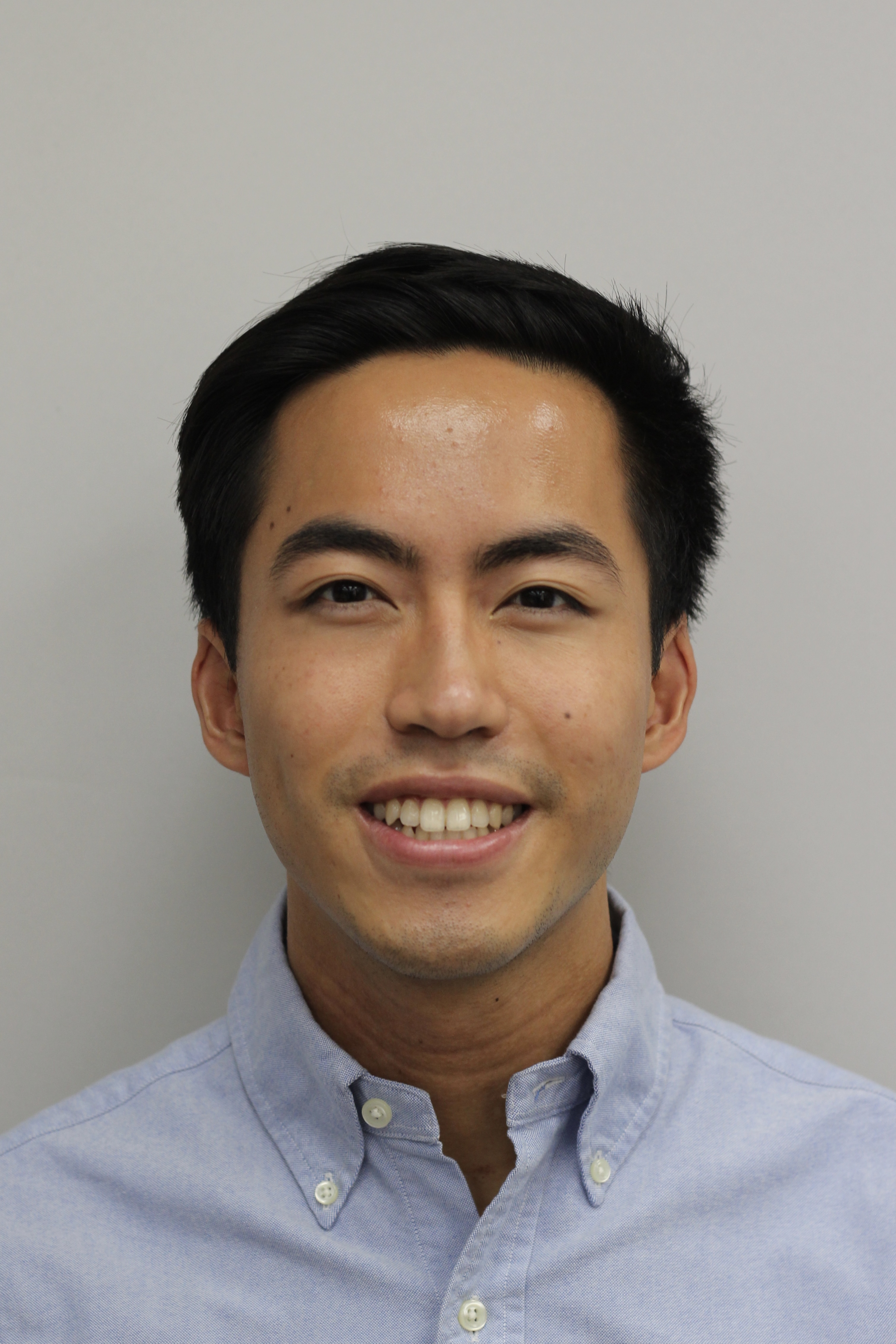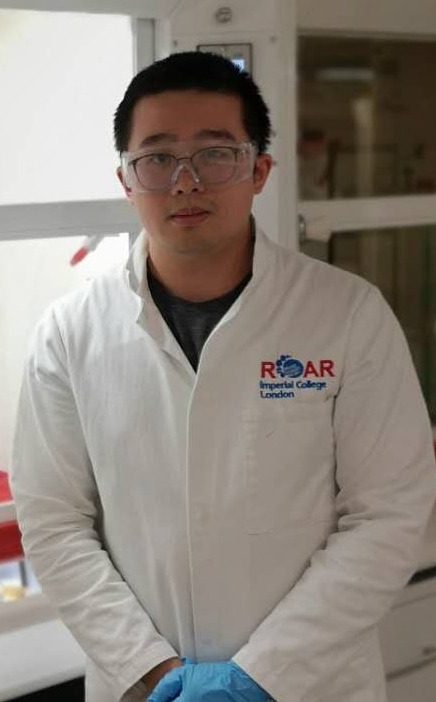EPSRC CDT React Cohort 3
- Callum John
- Georgina Rai
- Helen Tyrrell
- Hikaru Ishikura
- Janusz Siwek
- Jeremy Jubb
- Joseph Kaye
- Liberty Rockey
- Matthew Grannan
- Miguel Angel de Carvalho Servia
- Suhaib Nisar
- Wilson Wu
- Yifan Tang
What were you doing before joining the CDT?
Working as a lab technician, and before hand doing my Chemistry MSci, at the Univerisity of Bristol.
Why did you choose to apply to the CDT programme and in particular your project?
Project title: Automated Late-Stage C-H Diversification of Complex Drugs and Natural Products
The automation and data-led aspect of the CDT is something that really interests me, as someone who's only encountered "traditional" methods of doing chemistry up until now. The relevance of this type of chemistry is also becoming larger and larger, so I feel the skills I learn here will be extremely valuable in the years to come. My project choice was due to my interest in synthetic chemistry and pharmaceutical research within industry being a specific field that I am interested in pursuing after completing my PhD.
What are you looking forward the most within the CDT programme?
I'm most excited about working closely with a pharmaceutical partner, to give me an opportunity to gain insight into how the industry operates, as well as using the state-of-the-art facilities in White City to carry out my research.
A little bit about yourself, if you could choose to be an animal, what would it be and why?
A bird. Wouldn't it be great to fly?

I took a year out after my MSci and did some unqualified secondary teaching in science, with some science and maths intervention.
Why did you choose to apply to the CDT programme and in particular your project?
Project title: Automating the Understanding of Catalytic Aldehyde Synthesis
I chose the CDT programme because having a synthetic background, I was intrigued about learning new skills and techniques such as data analytics and using ROAR. Plus, the labs are so advanced I can't wait to work in them!
My project stood out for me as it aligns perfectly with my research experience and interests - organometallics and homogeneous catalysis. I am also excited to gain industrial experience as the project is co-funded by GSK.
What are you looking forward the most within the CDT programme?
I'm looking forward to getting back into the lab and working alongside some very talented people. I'm also looking forward to meeting new people and getting to know my cohort!
A little bit about yourself, if you could choose to be an animal, what would it be and why?
I would be a quokka, because they are the happiest animals in the world!
 What were you doing before joining the CDT?
What were you doing before joining the CDT?
Working as a Product Development Chemist at AkzoNobel for two years.
Why did you choose to apply to the CDT programme and in particular your project?
Project title: Enzyme Carbomimetics: Single site sustainable catalysts for alcohols amination
I realised how important the skills we would learn during the CDT are for working in industry e.g. design of experiments, data analysis, coding, high-throughput reactions and wanted to learn these skills thoroughly. I wanted a project that linked to some of my previous research and a link to sustainable chemistry was important to me.
What are you looking forward the most within the CDT programme?
Becoming an expert in a specific area of chemistry, being able to showcase my work at conferences and network with lots of people.
A little bit about yourself, if you could choose to be an animal, what would it be and why?
I would be a Giant Panda as they spend most of their day eating, are fluffy and cuddly but can also be feisty when needed!
 What were you doing before joining the CDT?
What were you doing before joining the CDT?
I did my MRes at Imperial and before that my undergraduate degree at the Maastricht Science Programme in the Netherlands.
Why did you choose to apply to the CDT programme and in particular your project?
Project Title: Small sp3-rich Rings as Design Elements for Medicinal Chemistry
I chose my project as I wanted to do synthetic chemistry that had applications towards medicinally and biologically relevant molecules. I decided to join the CDT as they provide a myriad of opportunities to collaborate with industrial partners and understand what industry wants from academia and vice versa.
What are you looking forward the most within the CDT programme?
I look forward to being part of a cohort as a postgraduate student and learning about various disciplines within chemistry, as well as having the opportunity to discuss chemistry with industrial collaborators.
A little bit about yourself, if you could choose to be an animal, what would it be and why?
I’m originally from Japan but have also lived in the USA, South Korea, and the Netherlands. In my free time, I enjoy playing football and reading technothrillers.
If I could be an animal, I would be a tardigrade as they’re extremely resilient and just generally cool micro animals.
 What were you doing before joining the CDT?
What were you doing before joining the CDT?
I studied Chemical Engineering at University of Bradford and came to Imperial to complete an MSc in Advanced Chemical Engineering.
Why did you choose to apply to the CDT programme and in particular your project?
Project Title: Towards the Rational Design and Scale-up of Green Photoreactors
I love tackling new challenges and expanding my toolbox with new skills, and the CDT program offers both: complex challenges of the next generation synthesis and the skills needed to overcome them. Its multidisciplinary training in data science and chemistry is perfect for an aspiring engineer who wants to make a meaningful change in how we create chemistry.
Scale-up and reaction engineering are at the core of my discipline and offer many unique challenges. I believe that with the help of powerful computational methods we can shine new light on photochemistry to make it more efficient and, with the help of our industrial partners, push new ambitious sustainability goals.
What are you looking forward the most within the CDT programme?
One of the things that I am looking forward to is mixing hands-on laboratory work with computational aspects of my project. But most of all I look forward to working with all the wonderful and brilliant people at the CDT.
A little bit about yourself, if you could choose to be an animal, what would it be and why?
I would be a Lemur because they very dynamic animals. They hate sitting still and love socialising, but are not afraid to go out on their own to get things done.
 What were you doing before joining the CDT?
What were you doing before joining the CDT?
I was an MChem student at Loughborough University focusing on organic synthesis, especially natural product synthesis.
Why did you choose to apply to the CDT programme and in particular your project?
Project title: Bromination in Flow
This program and my project allows me to further broaden my interest in organic synthesis and is paired with new technologies, such as flow chemistry. I hope to gather useful knowledge and experience in cutting edge organic chemistry, and apply these aspects in my future working life.
What are you looking forward the most within the CDT programme?
Learning and using many new innovative skills and techniques and applying these to a multitude of problems and challenges. Especially, broadening my experience with flow chemistry.
A little bit about yourself, if you could choose to be an animal, what would it be and why?
I would choose to be a Panther. I think they are very independent animals and function very good by themselves.
What were you doing before joining the CDT?
I was completing my Medicinal Chemistry MChem at the University of Leeds.
Why did you choose to apply to the CDT programme and in particular your project?
Project title: Machine guided Optimization of Organic Semi-conductor films for light activated antimicrobials and antiviral surfaces
I chose to apply to the CDT program as it offered an opportunity to expand and develop my skill set through the industry backed teaching and implementation of data science and chemical engineering to chemical analysis. My main research interests lie in medicinal and synthetic chemistry and this drew me to the ‘antimicrobial and antiviral surfaces’ project. The project aims to explore a novel solution to the growing threat of antimicrobial resistance, which for me is a thoroughly exciting project to explore.
What are you looking forward the most within the CDT programme?
I am most looking forward to working in the modern labs and getting the chance to operate new equipment. I am equally looking forward to working within a cohort and expanding my academic network whilst on the CDT, hopefully discussing chemistry over a few home cooked meals (or any good food establishment)!
A little bit about yourself, if you could choose to be an animal, what would it be and why?
I love to watch and play football in my spare time, or when home going for long hikes in the Peaks. I also enjoy socializing with mates, cooking, and reading. If I was an animal, I’d want to be a stag because they are wise, loyal and you get to go on many great hikes.

I spent two years working for a start up as a Product Development Scientist designing materials for water treatment applications.
Why did you choose to apply to the CDT programme and in particular your project?
Project title: Synthesis of functionalized materials for the removal of per and polyfluoroalkyl substances (PFAS) from water
The CDT is very multidisciplinary and has a strong focus on collaboration which is what attracted me to it. I think being able to work with a variety of individuals from different disciplines helps create better scientists and more robust data.
PFAS in water is an increasingly high-profile issue and the real-world application of the project makes me excited to get started!
What are you looking forward the most within the CDT programme?
I'm looking forward to learning new skills that can be readily translated to an industrial setting, particularly the data science and coding course.
A little bit about yourself, if you could choose to be an animal, what would it be and why?
I enjoying dancing, baking and cycling. If I was an animal, I would be a bumble bee - they're hard working and seem happy buzzing about eating all day which sounds pretty good!
What were you doing before joining the CDT?
I was studying an MChem at Durham University, where my Master's project focused on developing novel routes for trifluoropropynlation.
Why did you choose to apply to the CDT programme and in particular your project?
Project title: Dual Catalytic C–H Alkylation: An automated approach to reaction discovery
I chose the CDT primarily due to its focus on automation within synthetic chemistry, as I believe its implementation will become very significant in the near future. I also was interested in the interdisciplinary nature of the CDT, as I believe having knowledge in the fields of chemistry, chemical engineering and data science will give me a new perspective at tackling problems within my PhD.
I chose my project from my exposure to the benefit (as well as the drawbacks) of palladium-catalysed reactions during my Master's research. Due to the significance of these reactions within the chemical industry, being involved in developing effective C-H functionalised methods felt like a valuable and potentially ground-breaking prospect to me.
What are you looking forward the most within the CDT programme?
Collaboration with fellow PhD students, as well as learning new skills in fields I am not currently familiar with like data science.
A little bit about yourself, if you could choose to be an animal, what would it be and why?
I enjoy being active, more often than not through climbing or frisbee. If I could be an animal I would be a mountain goat due to their ability to climb cliff faces.

What were you doing before joining the CDT?
Project title: Discovering Intrinsic Catalytic Reaction Mechanisms: Using Machine Learning to 'Crack' Rate Expressions
What are you looking forward the most within the CDT programme?
If I could choose to be an animal, I would probably choose to be a monkey. Monkeys aside from being the jokesters of the jungle, they are also incredibly agile and intelligent. So, humorous, athletic and smart... what more could I ask?
 What were you doing before joining the CDT?
What were you doing before joining the CDT?
I completed my MEng in Chemical Engineering here at Imperial in 2020 (right when Covid made its triumphant arrival).
Why did you choose to apply to the CDT programme and in particular your project?
Project title: Optimisation of ionic liquid-based biomass processing
The projects offered by the CDT React programme were amongst the most exciting offered. The multidisciplinary nature of the work, and a particular focus on advanced data analysis coupled with my interests in chemical engineering and synthesis will help mould me into a more well-rounded researcher and prepare me well for life ahead.
I was especially attracted by my project, spanning both reaction engineering and process systems which were my favourite areas during my undergraduate years. I am also heavily invested in trying to improve the sustainability of our lives using natural sources, so this project fit in very well with my interests. In addition, the ability to also work in advanced synthesis labs, learning state-of-the-art biomass processing techniques and applying advanced optimisation algorithms in a tricky application motivated me to pursue this project.
What are you looking forward the most within the CDT programme?
I am eager to work with accomplished researchers from a multitude of backgrounds, learning from their experiences and hopefully bringing together different points of view and expertise to streamline synthesis applications in a range of industries, solving the many different engineering and synthesis challenges that the world faces.
A little bit about yourself, if you could choose to be an animal, what would it be and why?
I am from Pakistan, and hence am obviously a cricket fan. I am also an avid follower of Formula 1, as I appreciate the intertwined nature of cutting-edge engineering problems and politics tackled there. If I were an animal, I think I would be best placed as a beaver, as they are hard-working, clever and chip away at their problems without much fuss. If you have any questions, please do not hesitate to get in contact!
 What were you doing before joining the CDT?
What were you doing before joining the CDT?
Before joining the CDT, I was studying a MChem degree at the University of Edinburgh with a year abroad at ETH Zürich.
Why did you choose to apply to the CDT programme and in particular your project?
Project title: A combined experimental and machine-learning for the discovery of new chemical receptors.
I applied to the CDT programme because it provides opportunities to learn relevant skills for the future of physical science research, including learning about the synergy between automation and data science.
I chose my project in particular because I enjoy combining skills at the interface between different research fields. My project allows me to have expert supervision in three disciplines, chemistry, chemical engineering and data science.
What are you looking forward the most within the CDT programme?
I am most looking forward to getting to know the other CDT students in all three current cohorts. I also look forward to meeting my research groups as well as using the amazing facilities available, such as the department's exciting ROAR suite.
A little bit about yourself, if you could choose to be an animal, what would it be and why?
I enjoy all things mountaineering, be it indoor climbing to winter climbing. If I could be an animal I would be a bat because I am visually impaired or "blind as a bat" as some of my friends would say, so make sure to give me a big wave if you come across me in the corridors!
 What were you doing before joining the CDT?
What were you doing before joining the CDT?
I was at the University of Nottingham before I joined the MRes project at Imperial college.
Why did you choose to apply to the CDT programme and in particular your project?
Project title: HTE experimentation and automation in flow.
I joined in my first year as a MRes student. Before I joined, I think the idea of doing experiments more standardized and obtaining more qualified data is a very attractive idea. After I join the MRes program, we have been receiving training and information about how actually how these in-situ characterization method works, what are their limitation, and what task they could handle. It is very different from what we have in undergraduate while we talking about organic chemistry.
What are you looking forward the most within the CDT programme?
I think ROAR has a variety of equipment which would change the way we think about synthesis. I am looking forward to getting trained on these machines and designing some novel projects to see if we can push the boundary of chemistry a little bit further.
A little bit about yourself, if you could choose to be an animal, what would it be and why?
If I need to choose an animal, I would choose a tiger. Tiger is a predator, and it is also a very cunning animal.
